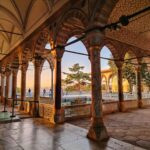Winter Palace, Russia: A Grand Legacy of Tsarist Opulence
The Winter Palace, located in the heart of St. Petersburg, Russia, stands as a monumental testament to the lavish life of the Russian Empire. This magnificent palace, once the official residence of the Russian tsars, is not only a marvel of architecture but also a symbol of imperial grandeur and a key part of Russian history. Let’s explore the history, significance, and enduring legacy of this iconic structure.
History of the Winter Palace
The Winter Palace was originally constructed between 1754 and 1762 under the reign of Empress Elizabeth of Russia, daughter of Peter the Great. It was designed by Bartolomeo Rastrelli, an Italian architect, and its opulent Rococo style was meant to reflect the power and wealth of the Russian monarchy. The palace served as the main residence of the Russian emperors from its completion until the fall of the Romanov dynasty in 1917.
The palace has undergone several expansions and renovations throughout its history. The most notable change was the addition of the classical-style wings in the early 19th century under the direction of Emperor Nicholas I. These modifications were designed by architects such as Auguste de Montferrand and Vasily Stasov. The palace’s grand interiors, including the Throne Room and the White Hall, are decorated with incredible artwork, chandeliers, and furniture befitting the imperial family.
Significance of the Winter Palace
The Winter Palace holds immense historical significance, not just for Russia but for the entire world. It has been the site of numerous historical events that shaped Russia’s destiny.
- Imperial Residence: For over 150 years, the palace was home to the Russian tsars and their families. It was the heart of the Russian monarchy, a place where royal decisions were made, and the pulse of the empire was felt.
- Russian Revolution: The Winter Palace was famously stormed during the Russian Revolution of 1917. This event marked the collapse of the Russian Empire and the beginning of Soviet rule. The storming of the palace on October 25, 1917, symbolized the overthrow of Tsar Nicholas II and the Romanov dynasty, making it one of the most iconic moments in Russian history.
- Cultural Importance: Today, the Winter Palace houses the Hermitage Museum, one of the world’s largest and most renowned art museums. The museum boasts an extensive collection of art, including works by artists such as Rembrandt, Leonardo da Vinci, and Michelangelo. The Winter Palace itself, with its regal interiors and stunning architecture, is considered a masterpiece of Baroque and Classical design.
Daily Life and Impact
In its prime, the daily life within the Winter Palace was one of unmatched luxury and extravagance. The royal court was a place of opulent feasts, cultural performances, and elaborate ceremonies. Empresses and tsars lived in grand suites filled with artwork and treasures from all corners of the globe. The palace’s halls and gardens were also venues for political meetings, where decisions that affected the empire’s future were made.
However, the palace’s role changed dramatically after the Russian Revolution. The Winter Palace became a symbol of the old regime, and its subsequent occupation by the Soviet government marked the end of a glorious era of tsarist Russia. Today, it serves as a museum, open to the public, offering visitors a glimpse into the opulent life of the Russian aristocracy and the political events that shaped the nation’s history.
Key Facts About the Winter Palace
- Architectural Design: The Winter Palace was designed in the Rococo style, a decorative and ornate style popular in Europe during the 18th century. The palace’s facade is over 500 meters long and is adorned with intricate details, including columns, sculptures, and decorative elements.
- The Hermitage Museum: The Winter Palace is part of the Hermitage Museum, which was founded by Catherine the Great in 1764. The museum is one of the most important cultural institutions in the world, with a collection that spans from ancient civilizations to contemporary art.
- The Tsar’s Private Rooms: Some of the most exquisite rooms in the palace include the Catherine the Great’s private suite and the Grand Staircase, which are breathtaking examples of imperial luxury.
- The Revolution: The storming of the Winter Palace on October 25, 1917, by Bolshevik forces marked a turning point in Russian history, leading to the downfall of the Romanov dynasty and the establishment of Soviet power.
- Museum Collection: The Hermitage Museum is home to over 3 million works of art, ranging from paintings and sculptures to antiquities and artifacts. It is a must-visit for art lovers from all over the world.
- Restoration and Preservation: The Winter Palace has undergone extensive restoration after several fires and damages throughout its history. The palace was largely restored after the Bolshevik Revolution and World War II, ensuring its preservation for future generations.
- World Heritage Site: The Winter Palace, along with the entire ensemble of St. Petersburg’s historic center, was designated a UNESCO World Heritage site in 1990.
Impact on Society
The Winter Palace continues to have a profound impact on Russian society and culture. As the Hermitage Museum, it remains an important institution for education, research, and the preservation of Russian and world heritage. It attracts millions of visitors annually, contributing to tourism and the cultural economy of St. Petersburg.
In addition, the palace serves as a reminder of Russia’s imperial past and the revolutionary events that forever altered its course. The dramatic events of the 1917 revolution and the palace’s subsequent transformation into a museum symbolize the profound societal shifts that took place during this period.
Conclusion: A Monument to Russia’s Imperial Legacy
The Winter Palace stands as a living testament to Russia’s imperial legacy, with its breathtaking architecture, rich history, and enduring significance. Whether you are an art enthusiast, history buff, or simply someone who appreciates the beauty of architectural splendor, the Winter Palace offers an unparalleled experience.
Today, the Winter Palace is more than just a historical building; it is a symbol of the changing tides of Russian history, an iconic landmark, and a cultural treasure that continues to captivate the world.











I’m gone to tell my little brother, that he should also pay
a visit this web site on regular basis to take updated from most up-to-date news.